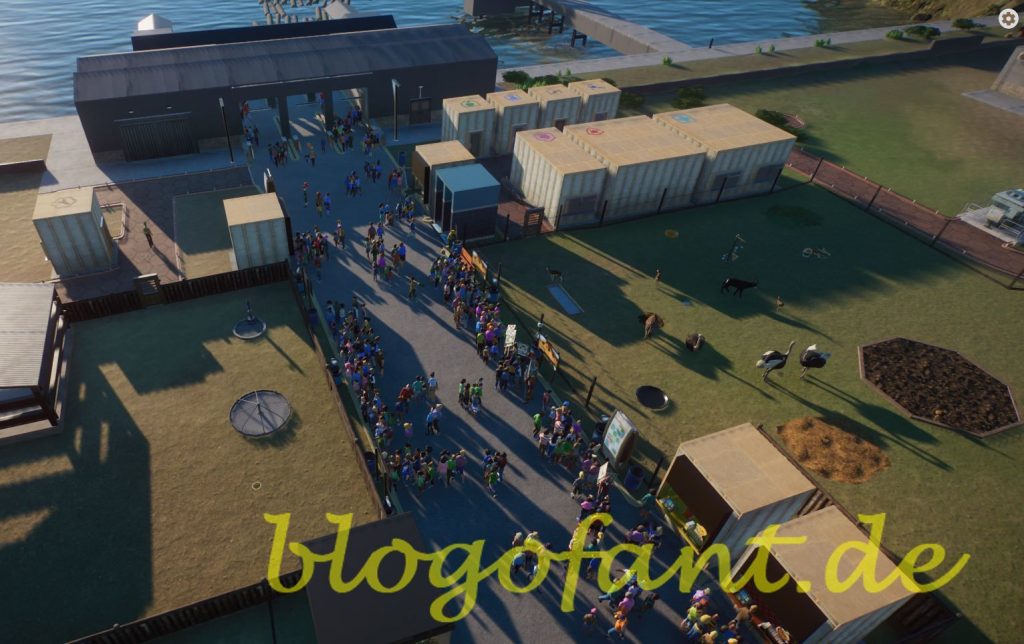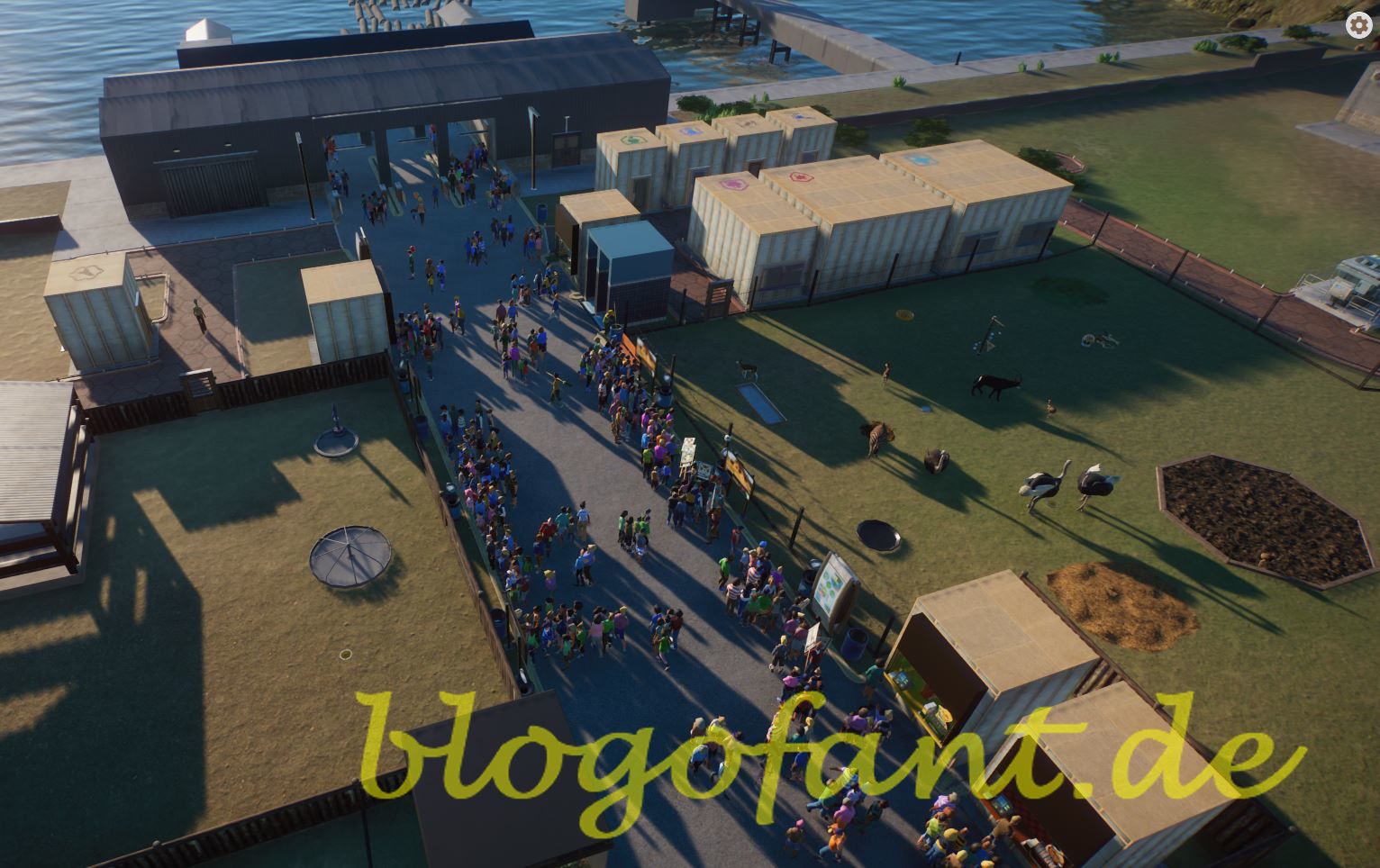This tutorial is about building a zoo with little money. Within a short time you will be able to welcome 500 zoo visitors and have 100,000 monetary units in your account. I would like to show you and explain exactly how this works in this Planet Zoo tutorial.
In the advanced campaigns of Planet Zoo you have a starting capital of 20,000 monetary units at the middle level. Of course, you can get a lot of money with a loan, but keep in mind that this money also has to be repaid on an ongoing basis. In addition, you also have interest expenses – in fact, an unnecessary move. 20,000 monetary units may sound like very little for the first time, but you can easily make ends meet with it. However, it is important that you understand the principle and logic behind the game.
Planet Zoo has built in some logic, which can make the game more difficult but also easier:
- New animals mean another rush of visitors
- Donation boxes next to information boards are particularly effective
Basic equipment – the zoo structure
First you need a basic set of equipment, which consists of the following buildings in the respective category. Also note that it makes sense to build a long and wide road first. This costs very little and you need it to absorb the rush in the zoo area.
Employee facilities
You should start with a service cross street from Hauptallee. Here you should build the following buildings, which will cost you exactly 6,000 monetary units. Note that everything should initially be built without additional decoration, as you can save up to 25% per building here.
- Animal keeper’s hut – is required for the animal keeper
- Research Center – is required for the veterinarian
- Workshop – is required for the technician
- Trade center – for buying animals
- Staff room – for the Staff
- You don’t need a quarantine or a veterinary practice to begin with. If animals get sick at the beginning, build the veterinary practice first and only then the quarantine.
Visitor facilities
Next, you should take care of the visitor facilities. Your visitors actually only have 5 basic needs: animals, food, drink, toilet and information. Everything else is a luxury for the time being. Here, too, you can rely on the simple buildings without decoration – after all, decoration is beautiful, but it costs money unnecessarily.
For this reason you should build the following visitor facilities:
- A toilet block – set the price to 0.30 monetary units to transfer part of the costs to the visitors
- a snack stand – increase every price there by 0.50 monetary units
- a drinks stand – increase every price there by 0.50 monetary units
- a information center – this is not absolutely necessary at the beginning but a nice to have for the zoo visitors
- an ATM – also set the price to 0.30 monetary units
- two species conservation boards < / strong> – do not select the first 3 categories here, as they are not so well received. Start working through the list from bottom to top
- Three benches
- Five garbage cans
- Six Donation boxes – 3 per enclosure
- Four information screens – 2 per enclosure
- Two loudspeakers – 1 per enclosure
Personnel
You need staff right from the start, but you can safely do without a security service for the time being. For this reason, you should hire the following staff:
- One zoo keeper – enough for one toilet and 5 trash cans
- One zoo keeper – however, there is always at least one zoo keeper
- Three salespeople – food stand, beverage stand and information stand. Another seller is luxury here, but should not be forgotten later if employees are on break
- A technician – he should start the technology research “beverage stands” immediately. In the beginning, the technician has nothing to fix, so this should be done. Don’t forget to either hire a second technician or pause the research after the first stage
- A veterinarian – they should research the animal species immediately to provide visitors with more information

Animals
With the animals, you should build one after the other. First the first species, wait until the number of visitors drops. You can then add the second species to your zoo. The number of visitors will increase, you will generate revenue again until a point in time when it decreases. Then a vivarium is recommended to lure zoo visitors back to the zoo.
While one animal species comes to around 80 zoo visitors, the second animal species already has up to 200 visitors. If you have 400 zoo visitors or more, you make so much profit that you only have to expand slowly with the same strategy.
At first you should choose animals that cause few problems. These are the “American bison”, the “gauntlet”, the “plains zebra”, the “African ostrich” or the “wolf”. These animals are inexpensive and require a small enclosure. In addition, they do not need any water (and therefore no water treatment system) and usually no air conditioning or heating.
Animals like the “springbok” should be avoided, as shy animals in particular are afraid of visitors and are quickly stressed. For the animals, stress means an immediate well-being of 0 percent and thus immediate protests from activists. You can counteract this with mirrored glass, but you won’t have researched it for a few years.
I would not recommend any “iguanas” for the vivarium animals. These are often immediately at a low level of wellbeing in the offspring. For now, concentrate on “cockroaching”, “hitting” and “spinning”. You should also not forget that vivarium animals also need an info screen and a donation box and must also be researched by the vet.
In short, my strategy would be:
- American bison or wolf as the first animal species in the enclosure
- Plains zebra or African ostrich as the second animal species in the second enclosure (these two can also be combined – always make the enclosure a little bigger)
- Australian cockroach as the first vivarium species
Temporary money problems – Planet Zoo Tutorial
Short-term money problems are usually not a problem, but are often homemade. You can do the following:
- Lower the salary of employees (even in the red zone, nobody will quit quickly)
- Increase the prices of the zoo (be careful with that!) – Better the prices are cheap and you Earned with donations (around three times the zoo’s income) and the shops
- Increase the prices at snack and drink stands
- Build a vivarium or a new enclosure including animals
- Put more donation containers on
The Bernie Goodwin Memorial Zoo – example in New York
Using the example of the last campaign (Bernie Goodwin Memorial Zoo on an island near New York), I would like to show you my zoo based on the strategy. As can be seen, there are exactly two enclosures – one on the left and one on the right. In addition, 4 stands (snack, drinks, information and a souvenir shop). There are already 500 visitors to this zoo and the financial assets have increased to 25,000 monetary units.
The wide street for the zoo visitors is also important here, so that there is not a large crowd. In any case, keep an eye on the satisfaction levels of the zoo visitors, often a second type of drink will soon be required.

Quick start to Planet Zoo
Here are some basic steps to get started with Planet Zoo:
- Create a New Game: When you start Planet Zoo, you can create a new game by clicking on “New Game” in the main menu. You will then be asked to select a difficulty level and a starting scenario.
- Build your zoo: Once you have started your game, you need to build your zoo. Use the Build Mode tool to place animal enclosures, feeding stations, walkways, decorations and more. Make sure each occupant has enough space, food, and water, and that visitors have enough viewing platforms to see the animals.
- Setting up animal enclosures: Choose the right enclosure for your animals and set it up according to their needs. Some animals require more trees and plants, while others require more rocks or water. Make sure the exhibit is fenced and that you have enough staff to care for the animals and keep the exhibits clean.
- Hire staff: You need staff to manage your zoo. Hire zookeepers to take care of the animals, mechanics to fix broken equipment and gardeners to take care of the plants in the zoo. Make sure you have enough staff to complete all tasks.
- Add visitor attractions: Your zoo should not only have animals, but also attract visitors. Add rides, restaurants, and gift shops to increase visitor satisfaction. Make sure that the prices are reasonable and that there are enough toilets and garbage cans in the zoo.
- Research and Development: You can unlock new animal species through research and development by building research stations and letting your scientists work. You can also unlock new exhibit types, decorations, and visitor attractions by earning enough Research Points.
- Keep an eye on finances: Make sure your zoo is profitable by generating enough revenue from paying visitors and selling souvenirs and food. Keep an eye on expenses, too, by only hiring as many staff as you need and keeping prices reasonable.
More information about Planet Zoo
I hope you enjoyed this Planet Zoo tutorial and it helps you to build your zoo. As soon as you have made enough money, you can of course build everything and attach importance to design and co. Have fun with the game.
You can find more interesting games , tutorials, tips and tricks on Overview page.
In the advanced campaigns of Planet Zoo you have a starting capital of 20,000 monetary units at the middle level. Of course, you can get a lot of money with a loan, but keep in mind that this money also has to be repaid on an ongoing basis. In addition, you also have interest expenses – in fact, an unnecessary move. 20,000 monetary units may sound like very little for the first time, but you can easily make ends meet with it. However, it is important that you understand the principle and logic behind the game.
Planet Zoo has built in some logic, which can make the game more difficult but also easier:
- New animals mean another rush of visitors
- Donation boxes next to information boards are particularly effective

